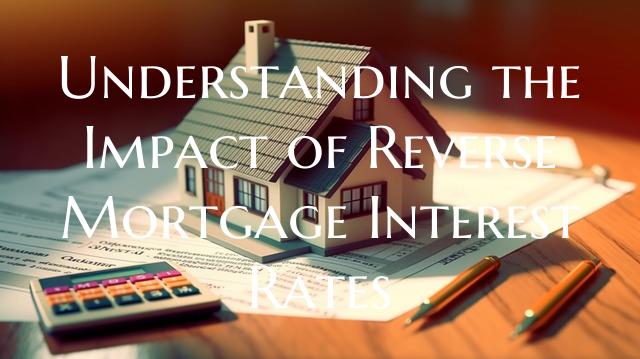Understanding the Impact of Reverse Mortgage Interest Rates

Reverse mortgages are unique financial products that allow homeowners aged 62 and older to convert a portion of their home equity into cash without having to sell their home. One important aspect of reverse mortgages to consider is the interest rate associated with the loan. Understanding how reverse mortgage interest rates work and their impact on the overall loan is crucial for borrowers looking to utilize this financial tool effectively.
1. How Reverse Mortgage Interest Rates are Determined: Reverse mortgage interest rates are typically higher than traditional mortgage rates due to the unique nature of these loans. The interest rate on a reverse mortgage is calculated based on the lender's margin, which is added to an index rate. Common index rates used for reverse mortgages include the London Interbank Offered Rate (LIBOR) or the Constant Maturity Treasury (CMT) rate. The margin, which is set by the lender, remains fixed for the duration of the loan but can vary between lenders.
2. Impact of Interest Rates on Loan Amount: The interest rate on a reverse mortgage has a direct impact on the total loan amount available to the borrower. A higher interest rate will result in a lower loan amount, as the interest that accrues on the loan balance over time will increase more rapidly. Borrowers should carefully consider the trade-off between interest rates and the amount of cash they can access through a reverse mortgage.
3. Effect on Borrower Obligations: Unlike traditional mortgages, borrowers are not required to make monthly payments on a reverse mortgage. However, the interest on the loan continues to accrue over time, increasing the overall balance owed. The interest rate plays a significant role in determining how quickly the loan balance will grow and can ultimately impact the amount of equity remaining in the home for heirs or the borrower's estate.
4. Strategies to Mitigate the Impact of High Interest Rates: Borrowers can take steps to mitigate the impact of high interest rates on a reverse mortgage. One strategy is to consider a reverse mortgage line of credit, which allows borrowers to access funds as needed and can help reduce the overall interest costs. Additionally, borrowers can explore options for refinancing their reverse mortgage if interest rates decrease in the future.
In conclusion, understanding the impact of reverse mortgage interest rates is essential for borrowers considering this financial option. By carefully evaluating how interest rates affect the loan amount, borrower obligations, and potential strategies to mitigate high rates, individuals can make informed decisions about whether a reverse mortgage is the right choice for their financial needs.
